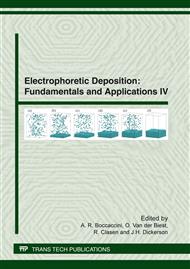p.47
p.53
p.61
p.67
p.73
p.79
p.85
p.89
p.95
Thin Films of Europium (III) Doped-TiO2 Prepared by Electrophoretic Deposition from Nanoparticulate Sols
Abstract:
Colloidal sol-gel is a common method used for the preparation of stable and homogeneous sols and thin films. The nanoparticulate sols can be easily deposited by EPD, which is a versatile technique for producing denser and thicker coatings than those produced by other techniques like dipping. A complete characterization of the sols, such as colloidal stability and electrophoretic mobility, which can be determined through zeta potential measurements, as well as the influence of deflocculants in the surface properties, is needed before using electrophoretic deposition. In this work, we have prepared sols of TiO2 with an alkoxide:water molar ratio of 50:1 and Eu (III) doped-TiO2 (2 mole % Eu (III)) using as precursors titanium (IV) isopropoxide and europium (III) acetate hydrate, respectively. The stability of the particulate sols was studied in terms of conductivity, zeta potential and viscosity evolution. Anatase stable sols, after peptization and without the use of any additive, were deposited on stainless steel substrates by electrophoretic deposition under both constant current and constant voltage conditions. Using different intensities and deposition times we have obtained thin films with different features (thicknesses and morphology) and different optical properties. The presence of europium (III) increases particle size, viscosity and peptization time and decreases the band gap of TiO2.
Info:
Periodical:
Pages:
73-77
Citation:
Online since:
March 2012
Keywords:
Price:
Сopyright:
© 2012 Trans Tech Publications Ltd. All Rights Reserved
Share:
Citation:


